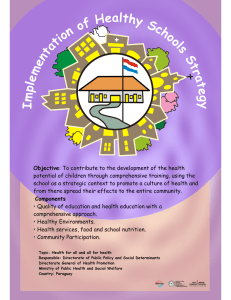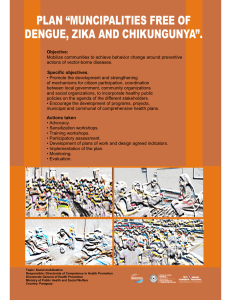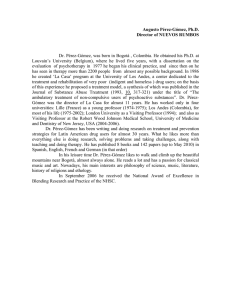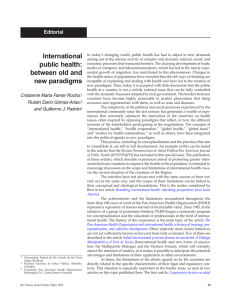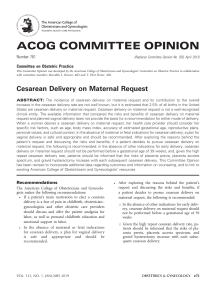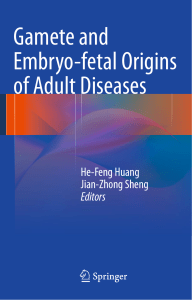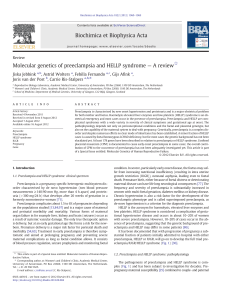ACCOMPLISHMENT OF THE MILLENNIUM DEVELOPMENT GOAL
Anuncio
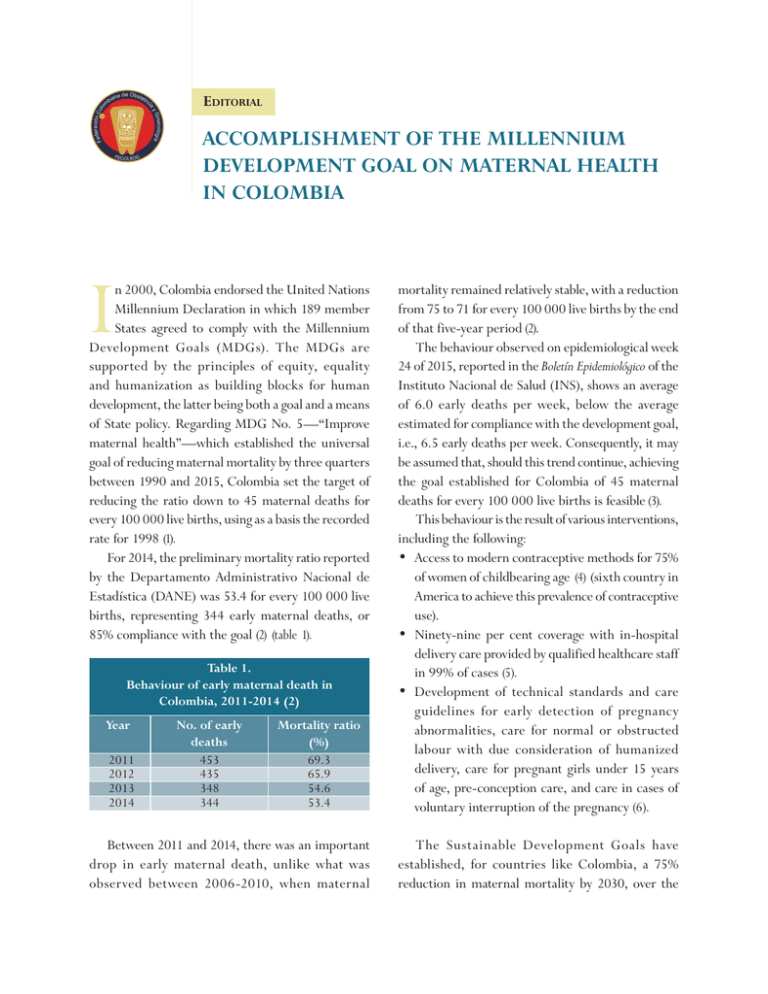
Editorial ACCOMPLISHMENT OF THE MILLENNIUM DEVELOPMENT GOAL ON MATERNAL HEALTH IN COLOMBIA I n 2000, Colombia endorsed the United Nations Millennium Declaration in which 189 member States agreed to comply with the Millennium Development Goals (MDGs). The MDGs are supported by the principles of equity, equality and humanization as building blocks for human development, the latter being both a goal and a means of State policy. Regarding MDG No. 5—“Improve maternal health”—which established the universal goal of reducing maternal mortality by three quarters between 1990 and 2015, Colombia set the target of reducing the ratio down to 45 maternal deaths for every 100 000 live births, using as a basis the recorded rate for 1998 (1). For 2014, the preliminary mortality ratio reported by the Departamento Administrativo Nacional de Estadística (DANE) was 53.4 for every 100 000 live births, representing 344 early maternal deaths, or 85% compliance with the goal (2) (table 1). Table 1. Behaviour of early maternal death in Colombia, 2011-2014 (2) Year 2011 2012 2013 2014 No. of early deaths 453 435 348 344 Mortality ratio (%) 69.3 65.9 54.6 53.4 Between 2011 and 2014, there was an important drop in early maternal death, unlike what was observed between 2006-2010, when maternal mortality remained relatively stable, with a reduction from 75 to 71 for every 100 000 live births by the end of that five-year period (2). The behaviour observed on epidemiological week 24 of 2015, reported in the Boletín Epidemiológico of the Instituto Nacional de Salud (INS), shows an average of 6.0 early deaths per week, below the average estimated for compliance with the development goal, i.e., 6.5 early deaths per week. Consequently, it may be assumed that, should this trend continue, achieving the goal established for Colombia of 45 maternal deaths for every 100 000 live births is feasible (3). This behaviour is the result of various interventions, including the following: • Access to modern contraceptive methods for 75% of women of childbearing age (4) (sixth country in America to achieve this prevalence of contraceptive use). • Ninety-nine per cent coverage with in-hospital delivery care provided by qualified healthcare staff in 99% of cases (5). • Development of technical standards and care guidelines for early detection of pregnancy abnormalities, care for normal or obstructed labour with due consideration of humanized delivery, care for pregnant girls under 15 years of age, pre-conception care, and care in cases of voluntary interruption of the pregnancy (6). The Sustainable Development Goals have established, for countries like Colombia, a 75% reduction in maternal mortality by 2030, over the 91 rate recorded in 2010. This means that the expected maternal mortality for Colombia is 24 for every 100 000 live births (7). However, a series of determining factors that have a negative influence on maternal health still prevail (8, 9) which, if not addressed properly, will slow down the trend observed in the last five years, making the achievement of this objective relatively unfeasible. Consequently, acting on the structural determinants is a high priority (10), the aim being to address inequalities that result in a higher risk of maternal death in the extreme ages of reproductive life, namely among women under 14 years of age (52.4 for every 100 000 live births) and in women older than 35 (140.6 for every 100 000 live births). Other determinants that need to be addressed relate to women living in rural areas (relative risk 2.1) where access is restricted by geographic barriers, security issues, deficiencies in road infrastructure and communications in general; (5) women under the subsidized regime (66% of the cases); and in women with no schooling or just primary education (one out of every three maternal deaths) (10). All of these factors create large regional gaps resulting in reported maternal mortality ratios above 140 for every 100 000 live births in 2014 in departments like Chocó, Putumayo and La Guajira, and unacceptably high ratios greater than 300 for every 100,000 live births in Guaviare, Guainía and Vichada (2). These inequalities are directly related to weaknesses in the implementation and ownership of maternal health policies. For this reason, territorial entities will have to ensure long-term comprehensive action along the continuum of preconception, pregnancy and postpartum care. This will require commitment with the implementation of all the forms of intervention developed in Colombia within the context of safe motherhood. Preconception care models have been developed in Colombia (11) in response to the change in the epidemiological profile of maternal deaths, which shows clear evidence of an increase in indirect causes such as oncological problems, heart diseases, neurological complications and autoimmune diseases, among others (4, 12). Also within this context of public policy, technical standards and care guidelines have been developed with significant input from the academic community and the scientific societies for early detection of pregnancy abnormalities, care of normal and obstructed childbirth under the tenets of humanized delivery (13), care of pregnant girls under 15 years of age (14), and guidelines for voluntary interruption of pregnancy as provided for under court ruling C-355/06 (15). Considering that 60% of the causes of maternal death are associated with the triad of hypertensive disorders, bleeding complications and sepsis (16), and considering that in 90% of cases there are flaws during the care process mainly as a result of inadequate management of obstetric emergencies (17), an alliance established in 2010 between the Ministry of Health and the Colombian Federation of Obstetrics and Gynaecology (FECOLSOG) developed a clinical safety model for the care of obstetric emergencies, now in the process of implementation (18). This model includes the assessment of the responsiveness of care providers in emergency cases, as well as the detection and analysis of extreme cases of maternal morbidity, as essential elements in identifying opportunities for improvement. This will give new thrust to coverage and quality of care, and will help with the adoption of tools designed to facilitate the implementation of improvement plans, including checklists, flow diagrams for quality management of emergencies, supply kits, and training activities for correct recognition, management and referral under an initiative called “Key practices that save lives”. We may assume that public policy contains all the essential elements to ensure sustained progress in this area. Unfortunately, poverty, mismanagement of resources in the most critical areas of the country (where mortality rates are 14 times higher) (8), lack of engagement and commitment on the part on some insurers, and inadequate compensation for healthcare 92 Revista Colombiana de Obstetricia y Ginecología Vol. 66 No. 2 • 2015 providers and practitioners involved in maternal health are associated with failed implementation and ownership of public policy. It is counterintuitive that although the progress achieved in Colombia in the field of public policy is considered an example to be followed by other countries in Latin America, the continuity of the process is by no means guaranteed, even thought there is clarity regarding what needs to be done (19). Consequently, the government must make this a priority focus. It is a source of concern to see that although the reduction of maternal mortality is included among the goals for the 2015-2017 development plan, the inclusion of maternal health actions under a mother-and-child approach as if they were ancillary matters and not an essential component of the effective realization of sexual and reproductive rights, blurs progress towards the guarantee, promotion and protection of women’s rights as the cornerstone of all interventions designed to reduce maternal morbidity and mortality (20). Edgar Iván Ortiz-Lizcano, MD, MSc Specialist in Obstetrics and Gynaecology and Master in Public Health Fellow of the American College of Obstetricians and Gynaecologists President of the Colombian Federation of Obstetrics and Gynaecology (FECOLSOG) President of the Latin-American Federation of Obstetrics and Gynaecology Societies (FLASOG) REFERENCES 1. Documento Conpes Social 140, Consejo Nacional de Política Económica y Social. Colombia: Departamento Nacional de Planeación; 2011.Departamento Administrativo Nacional de Estadística (DANE). [Visitado 2015 Jun 1]. Disponible en: www. dane.gov.co 2. Departamento Administrativo Nacional de Estadística (DANE). Estadísticas vitales (defunciones y nacimientos). Muertes maternas notificadas a Sivigila (semana epidemiológica 24 del 2015). Bogotá: DANE; 2015. 3. Instituto Nacional de Salud (INS). Informe del evento Mortalidad Materna a semana 24. Bogotá: INS; 2015. 4. Profamilia - Ministerio de Salud y Proteccion Social. Encuesta Nacional de Demografia y Salud. Bogotá: Profamilia - Ministerio de Salud y Proteccion Social; 2010. 5. Departamento Nacional de Planeación (DNP). Informe de seguimiento de los Objetivos de Desarrollo del Milenio. Bogotá: DNP; 2014. 6. Prada E, Singh S, Remez L, Villareal C. Embarazo no deseado y aborto inducido en Colombia. Causas y consecuencias. Nueva York: Guttmacher Institute; 2011. 7. United Nations, General Assembly. Report of the Open Working Group of the General Assembly on Sustainable Development Goals. General Assembly, 68 session. New York: United Nations; 2014. 8. Houweling TA, Ronsmans C, Campbell OM, Kunst AE. Huge poor-rich inequalities in maternal care, an international comparative study of maternity and child care in developing countries. Bull World Health Organ. 2007;65:745-54. 9. Cárdenas LM, Cotes K, Chaparro PE, Fernández JA, Paternina A, Castañeda C, et al. Maternal Mortality in Colombia in 2011: a two level ecological study. PLoS One. 2015;10:e0118944. 10.Ministerio de Salud y Protección Social. ASIS - Análisis de la situación de salud, Colombia 2013. Bogotá: Ministerio de Saud y Proteccion Social; 2013. 11.Ministerio de Salud y Protección Social, Dirección de Promoción y Prevención. Protocolo de atención preconcepcional. Bogotá: Ministerio de Salud y Protección Social; 2014. 12.Lumbiganon P, Laopaiboon M, Intarut N, Vogel JP, Souza JP, Gülmezoglu AM, et al. Indirect causes of severe adverse maternal outcomes: a secondary analysis of the WHO Multicountry Survey on Maternal and Newborn Health. BJOG. 2014;Suppl 1:32-9. 13.Colciencias - Ministerio de Salud y Protección Social. Guía de Práctica Clínica (GPC) para la prevención, detección temprana y tratamiento de las alteraciones del embarazo. Bogotá: Colciencias Ministerio de Salud y Protección Social; 2013. 93 14.Ministerio de Salud y Protección Social - Fondo de Población de las Naciones Unidas. Protocolo de atención a la embarazada menor de 15 años. Bogotá: Ministerio de Salud y Protección Social - Fondo de Población de las Naciones Unidas; 2014. 15.Ministerio de Salud y Protección Social - Fondo de Población de las Naciones Unidas. Prevención del aborto inseguro en Colombia. Protocolo para el sector salud. Bogotá: Ministerio de Salud y Protección Social -Fondo de Población de las Naciones Unidas; 2014. 16.Say L, Chou D, Gemmill A, Tunçalp Ö, Moller AB, Daniels J, et al. Global causes of maternal death: a WHO systematic analysis. Lancet Glob Health. 2014;2: e323-33. 17.Fundación Santafé de Bogotá CEIS - Ministerio de Salud y Protección Social - Fondo de Población de las Naciones Unidas. Análisis descriptivo de los casos de mortalidad materna 2007, de evaluación de impacto de las estrategias desarrolladas en el nivel nacional y regional para la reducción de la mortalidad materna en el país en el marco del SGSSS. Bogotá: Fundación Santafé de Bogotá CEIS - Ministerio de Salud y Protección Social - Fondo de Población de las Naciones Unidas; 2007. p. 131-36. 18.Guerrero J, Ortiz E, Sarria O, Gallego G. Modelos de seguridad para la atención de la emergencia obstétrica en instituciones de salud. Bogotá: Ministerio de Salud y Protección Social - Fondo de Población de las Naciones Unidas; 2014. 19.Colombia es ejemplo de salud materno-infantil en México. Junio 2012. [On-line]. [Visited 2014 Jun 25]. Available at: http://www.elhospital.com/eh/secciones/ EH/ES/MAIN/N/NOTICIAS2/doc_88202_ HTML. html?idDocumento=88202. 20.López A, Benia W, Contera M, Guida C, Echeveste L. Del enfoque materno infantil al enfoque de la salud reproductiva, de salud, género, derechos sexuales y reproductivos. Diálogos entre la universidad y organizaciones de la sociedad civil. Montevideo: Cátedra Libre en Salud Reproductiva, Sexualidad y Género, Universidad de la República; 2003. p. 175-218.
